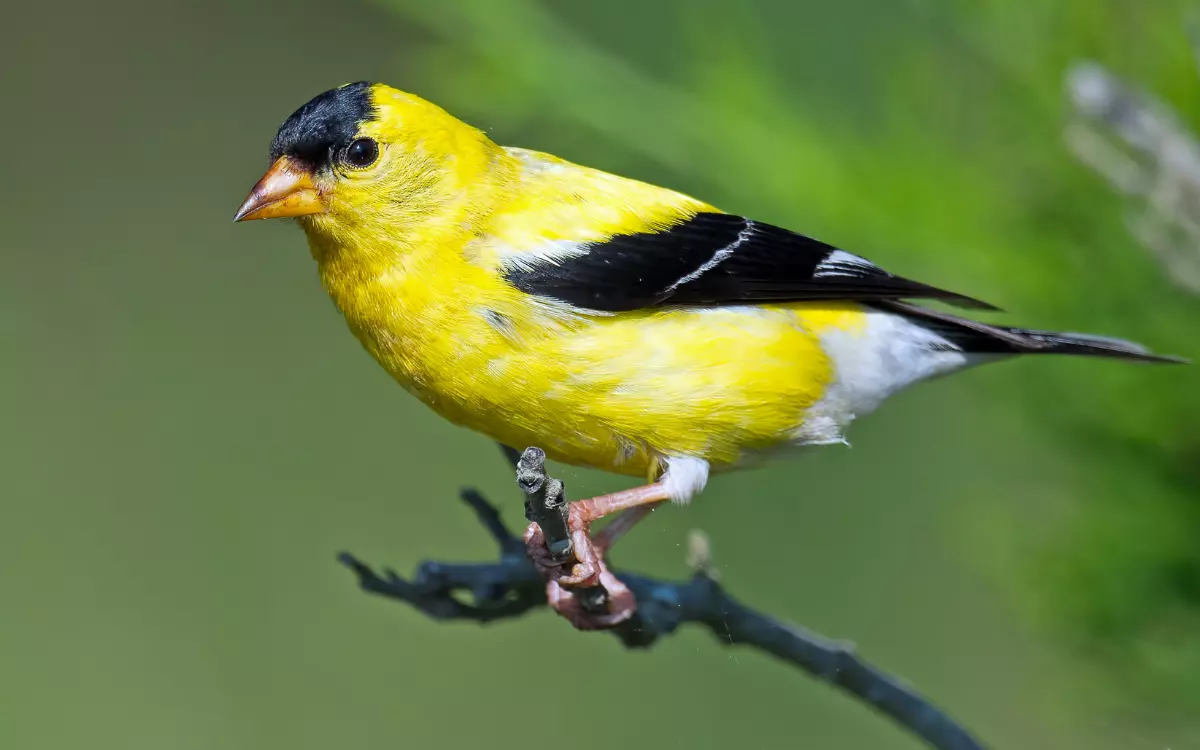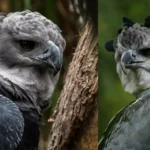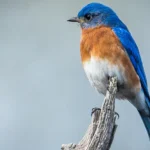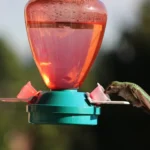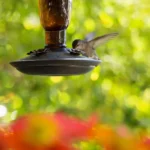In Texas, there are more than 600 bird species living. Some of them are yellow breast also few bird have yellow belly birds you can find in this list that help you to identify their name, unique habits, and more.
List of Yellow Breast Birds in Texas
| Yellow Breast Birds in Texas in Summer | Percentage (%) |
| Painted Bunting | 21.0% |
| Western Kingbird | 15.5% |
| Summer Tanager | 11.7% |
| Lesser Goldfinch | 10.5% |
| Dickcissel | 8.6% |
| Orchard Oriole | 6.4% |
| Yellow Warbler | 6.2% |
| Eastern Meadowlark | 5.7% |
| Common Yellowthroat | 5.7% |
| American Redstart | 4.4% |
| Magnolia Warbler | 4.1% |
| Cedar Waxwing | 4.0% |
| Couch’s Kingbird | 3.6% |
| Baltimore Oriole | 3.0% |
| Wilson’s Warbler | 2.9% |
| Pine Warbler | 2.3% |
| Nashville Warbler | 2.2% |
| Yellow-throated Vireo | 1.9% |
| Scott’s Oriole | 1.8% |
| Hooded Oriole | 1.3% |
| Prothonotary Warbler | 1.3% |
| Canada Warbler | 1.3% |
| Hooded Warbler | 1.1% |
| Yellow-throated Warbler | 1.1% |
| Western Meadowlark | 1.0% |
| Western Tanager | 0.9% |
| Yellow-headed Blackbird | 0.8% |
| Scarlet Tanager | 0.8% |
| Altamira Oriole | 0.8% |
| Tropical Kingbird | 0.7% |
| American Goldfinch | 0.6% |
| Audubon’s Oriole | 0.3% |
| Blue-winged Warbler | 0.2% |
| Cape May Warbler | 0.2% |
| Prairie Warbler | 0.2% |
| Palm Warbler | <0.1% |
1. Western Kingbird – (Tyrannus verticalis)
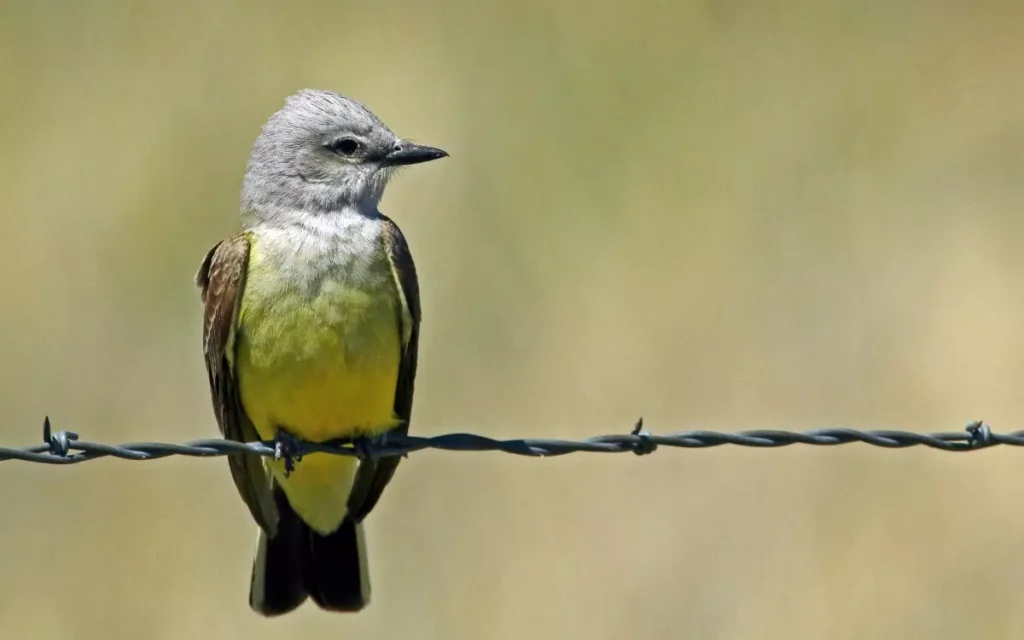
- Length: 7.9 – 9.4 in ( 20 – 24 cm)
- Weight: 1.3 – 1.6 oz (37- 46 gm)
- Wingspan: 15.0 – 16.1 in (38 – 41 cm)
- Lifespan: about 6 years
Call:-
The Western Kingbird is a member of the Tyrannidae family, which includes various species of flycatchers.
These birds are often seen perched on wires, fence posts, or treetops, where they scan the surroundings for flying insects.
Western Kingbirds are recognized for their sharp, “kip” or “kip-ee” calls, which they use for communication and territory defence.
They are excellent aerial hunters and are often seen catching insects in mid-air during acrobatic flights.
Western Kingbirds are cavity nesters, which means they often choose sheltered locations for their nests.
They commonly nest in trees, shrubs, or even man-made structures like fence posts and utility poles.
The female Western Kingbird typically lays a clutch of 3 to 7 eggs, although 4 to 5 eggs are most common.
Western Kingbirds engage in breeding from late spring to early summer, typically from May to July. The eggs are pale blue or greenish-blue and may have small spots or speckles.
2. Lesser Goldfinch-(Spinus psaltria)
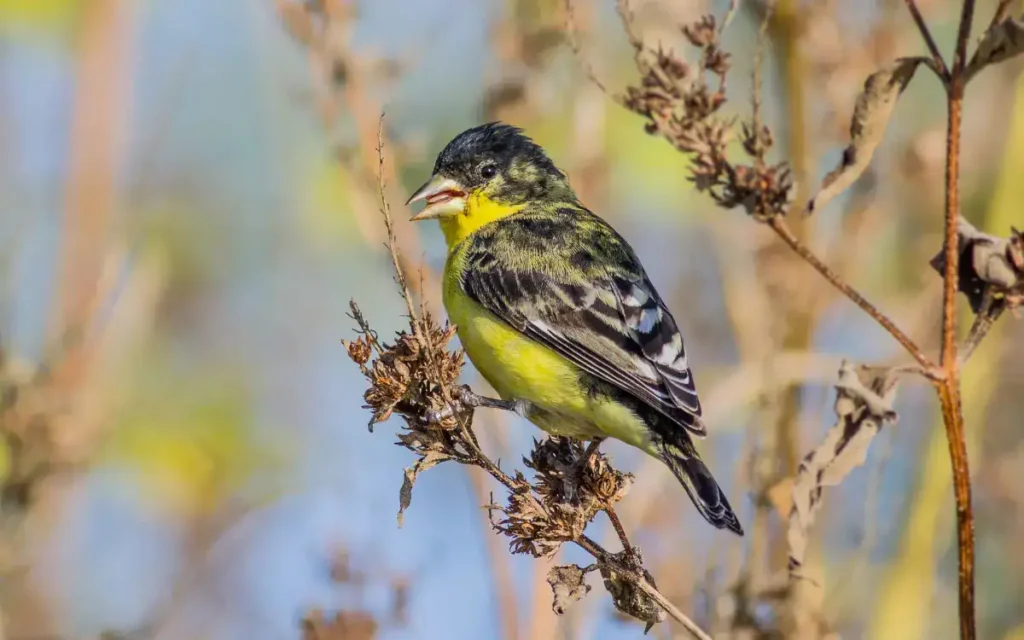
- Length: 3.5 – 4.7 in (9-12 cm)
- Weight: 0.28 – 0.41 oz (8 -11.5 gm)
- Wingspan: 7.87 in (20 cm)
- Lifespan: at least 7 years
Call:-
The Lesser Goldfinch is a small, colorful songbird known for its striking appearance. Adult males have bright yellow plumage with a black cap on their heads, while females and juveniles have more subdued greenish-yellow coloring.
They are avid singers and are often heard chirping melodious tunes. Their cheerful songs add a delightful ambiance to gardens and natural habitats.
One of their favorite foods is thistle seeds, and they are often attracted to bird feeders filled with thistle or nyjer seeds
The nests of Lesser Goldfinches are small and compact, typically built in shrubs, trees, or tall grasses. They use plant fibers, grasses, and fine twigs to construct their nests.
They breed during the warmer months, usually from late spring through summer, depending on their geographical location.
A typical clutch laid by the female Lesser Goldfinch consists of 2 to 6 pale blue or greenish-blue eggs with small speckles.
3. Cedar Waxwing – (Bombycilla cedrorum)
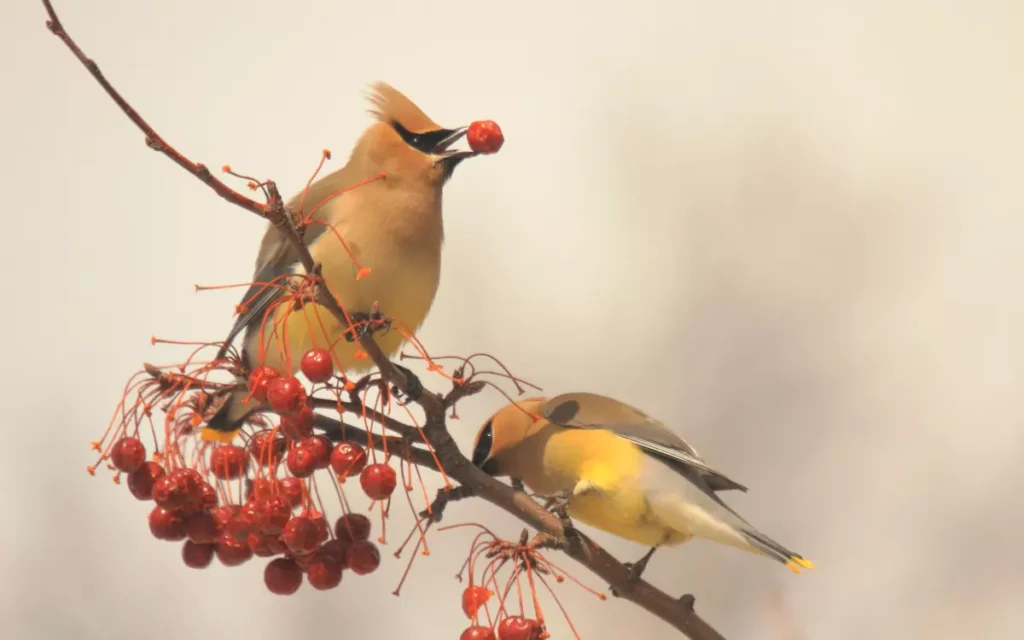
- Length: 6 – 8 in (15-20 cm)
- Weight: 1 oz (28 gm)
- Wingspan: 12-30 in (30 -76 cm)
- Lifespan: up to 8 years in the wild
Call:-
Cedar Waxwings are known for their sleek and silky appearance. They have a soft, brownish-gray plumage with a distinct black mask covering their eyes and a bright yellow band at the tip of their tails. They are often spotted in large, tight-knit flocks.
Their social nature is evident in their synchronized movements and harmonious calls.
They have a strong preference for fruit, especially berries. They are known for their graceful, acrobatic flights as they catch flying insects, and they are equally adept at plucking berries from trees and bushes.
These birds construct nests using materials like twigs, grass, and moss. They often incorporate their nests into the dense foliage of trees or shrubs.
Cedar Waxwings generally breed during the summer months, often from late spring through mid-summer, depending on their geographical location.
The clutch size of Cedar Waxwings typically consists of 2 to 6 pale blue eggs with irregular markings.
4. Eastern Meadowlark – (Sturnella magna)

- Length: 7.5 -11 in (19 – 28 cm)
- Weight: 2.7 – 5.3 oz (76 – 150 gm)
- Wingspan: 14-16 in (35-40 cm)
- Lifespan: about 3-9 years
Call:-
Eastern Meadowlarks are renowned for their melodious songs, which are often described as cheerful, flute-like whistling. Their songs are a common sound in open grassy fields.
While they have striking yellow underparts adorned with a prominent black V-shaped bib on their chests, their overall plumage is cryptic and camouflaged, helping them blend into their grassy habitats.
They are primarily insectivores, feeding on a wide variety of insects such as grasshoppers, crickets, beetles, and spiders. They play a role in controlling insect populations in their habitats.
They build their nests directly on the ground, often concealed in the thick grasses. The nest is a cup-shaped structure made of grass, leaves, and fine plant materials.
They breed during the spring and early summer months, typically from March to July, depending on their geographical location.
Female Eastern Meadowlarks typically lay a clutch of 3 to 6 eggs, although 4 to 5 eggs are more common.
5. Painted Bunting – Female (Passerina ciris)
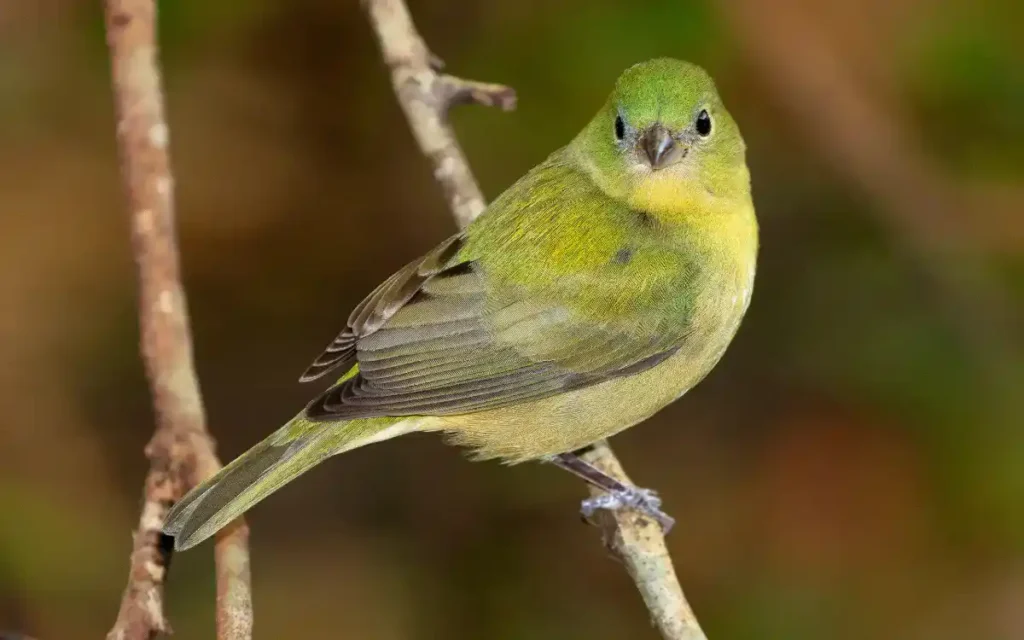
- Length: 4.7 – 5.1 in (12-13 cm)
- Weight: 0.56 oz (16 gm)
- Wingspan: 8.3 – 9.1 in (21- 23 cm)
- Lifespan: over 10 years
Call:-
The female Painted Bunting, while less colorful than her male counterpart, possesses subtle beauty with olive-green plumage.
Her cryptic appearance, allows her to blend seamlessly into the foliage. These females maintain their energy with a diet that primarily consists of seeds and insects.
During the summer months, they also enjoy indulging in fruits, adding variety to their nutrition.
During breeding season, which spans late spring to summer, she lays clutches of 3-5 eggs with pale blue or green hues. These enchanting females play a vital role in preserving the Painted Bunting’s stunning legacy.
6. Cape May Warbler – (Setophaga tigrina)
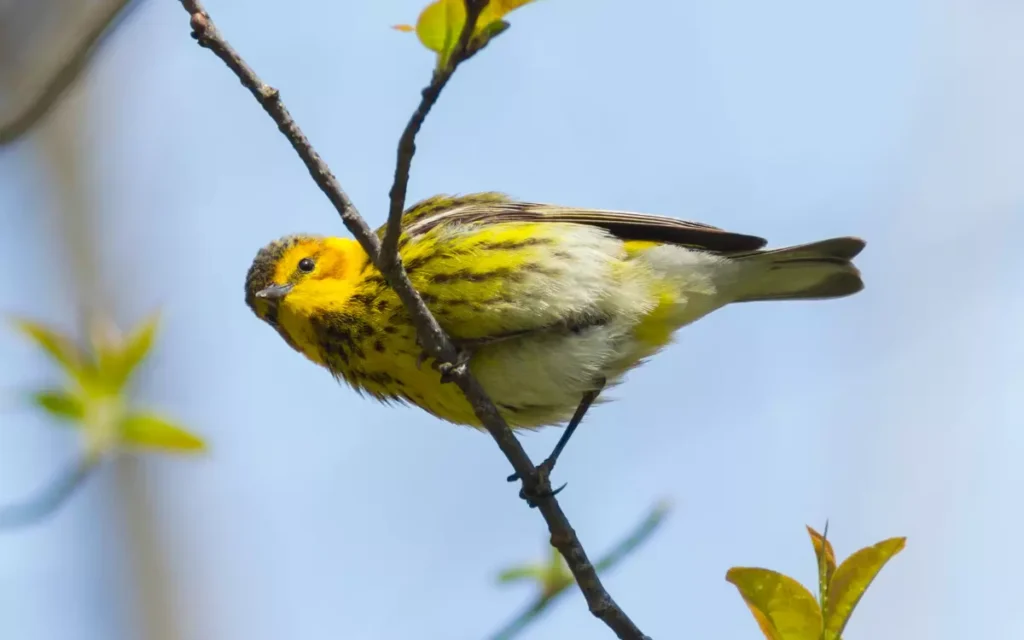
- Length: 4.7 – 5.5 in (12-14 cm)
- Weight: 0.32 – 0.61 oz ( 9 -17.3 gm)
- Wingspan: 7.5 – 8.7 in (19 – 22 cm)
- Lifespan: about (4.3 – 4.5 ) years
Call:-
These warblers are known for their striking appearance during the breeding season, featuring a chestnut cheek patch, yellow throat, and intricate black streaks on a white background.
Cape May Warblers are primarily insectivorous, feeding on a diverse diet of insects, spiders, and nectar. During migration, they have a particular fondness for sipping nectar from flowers, making them one of the few warbler species with a taste for sweets.
The female Cape May Warbler constructs a cup-shaped nest using fine twigs, grass, and other plant materials.
Breeding season occurs during the summer months, usually from May to July. The female Cape May Warbler typically lays a clutch of 4 to 7 eggs with pale backgrounds speckled with fine dark markings.
7. Summer Tanager Female – (Piranga rubra)

- Length: 8 in (20 cm)
- Weight: 0.9 -1.1 oz (29 – 30 gm)
- Wingspan: 11 – 12 in (28 – 30 cm)
- Lifespan: about 4 – 6 years
Call:-
These tanagers are known for their aerial acrobatics as they capture flying insects in mid-air. but her subtle beauty lies in her olive-yellow feathers, which provide excellent camouflage.
Summer Tanager females are skilled insectivores, primarily feasting on a variety of flying insects, including bees, wasps, ants, flies, and more.
They occasionally supplement their diet with berries and fruit.
Their nests are cup-shaped and constructed using materials such as twigs, grass, and leaves.
Summer Tanagers breed during the summer months, which aligns with the warmer weather and increased insect activity.
The female usually lays a clutch of 2 to 5 eggs with pale backgrounds, marked with tiny speckles.
8. American Goldfinch – (Spinus tristis)

- Length: 4.3 – 5.1 in (11 – 13 cm)
- Weight: 0.4 – 0.7 oz (11 – 20 gm)
- Wingspan: 7.5 – 8.7 in (19 – 22 cm)
- Lifespan: 9 – 11 years
Call:-
American Goldfinches are unique among North American birds for their seasonal molt. During the breeding season in late spring and summer, males don vibrant lemon-yellow plumage with striking black caps and wings, while females sport a more subdued yellow-green coloration.
In winter, both sexes transition to a drab olive-brown plumage.
These finches are particularly fond of sunflower seeds, making them frequent visitors to bird feeders stocked with sunflower seeds or Nyjer (thistle) seeds.
During the breeding season, they may supplement their seed-heavy diet with insects, providing essential protein for their nestlings.
They are late-nesting birds, often starting their breeding activities in July or August When many other bird species have already completed their nesting they breed during the late summer, usually from June to September.
Clutches typically consist of 4 to 6 pale blue-green eggs, each measuring around 0.6 inches (1.5 cm) in length.
9. Pine Warbler – (Setophaga pinus)
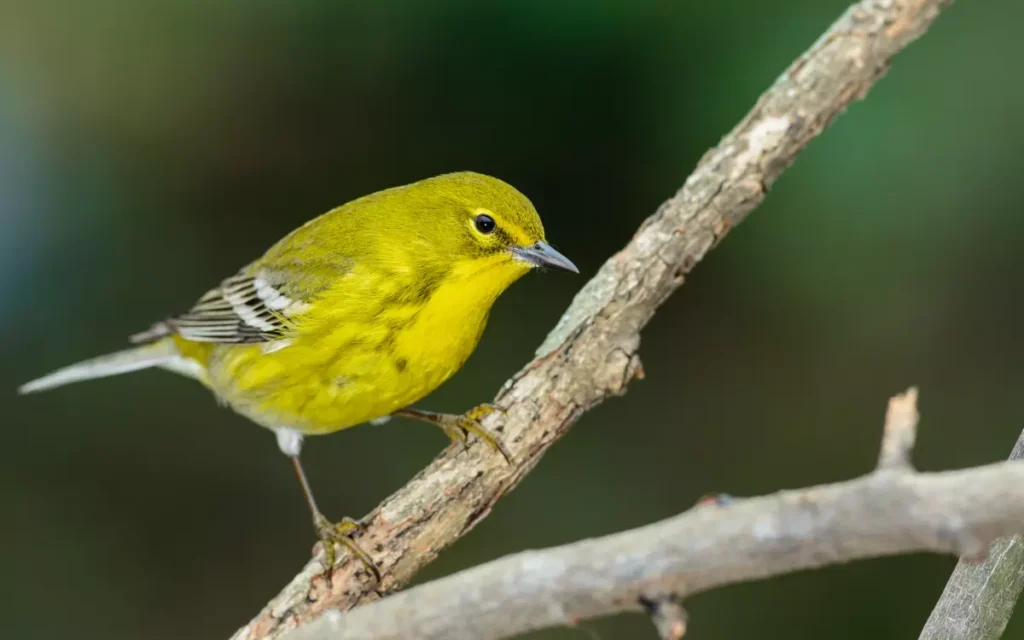
- Length: 5.1 – 5.5 in (13 – 14 cm)
- Weight: 0.3 – 0.5 oz (9 – 15 gm)
- Wingspan: 7.5-9 in (19-23 cm)
- Lifespan: up to 6 years
Call:-
Pine Warblers are known for their cheerful, musical songs that echo through pine forests.
They are skilled acrobats, often seen hanging upside down to forage for insects.
These birds are excellent mimics, imitating the calls of other bird species.
Pine Warblers primarily feed on insects, spiders, and pine seeds. Their diet is diverse, ensuring they have the energy for their vibrant songs and aerial displays
Pine Warblers construct cup-shaped nests high in pine trees. They are meticulous builders, using pine needles, grass, and bark to create a cozy home for their offspring.
Breeding season for Pine Warblers usually begins in April and lasts until June. They typically lay a clutch of 2-5 eggs, which are pale blue or green with speckles.
10. Prairie Warbler- (Setophaga discolor)
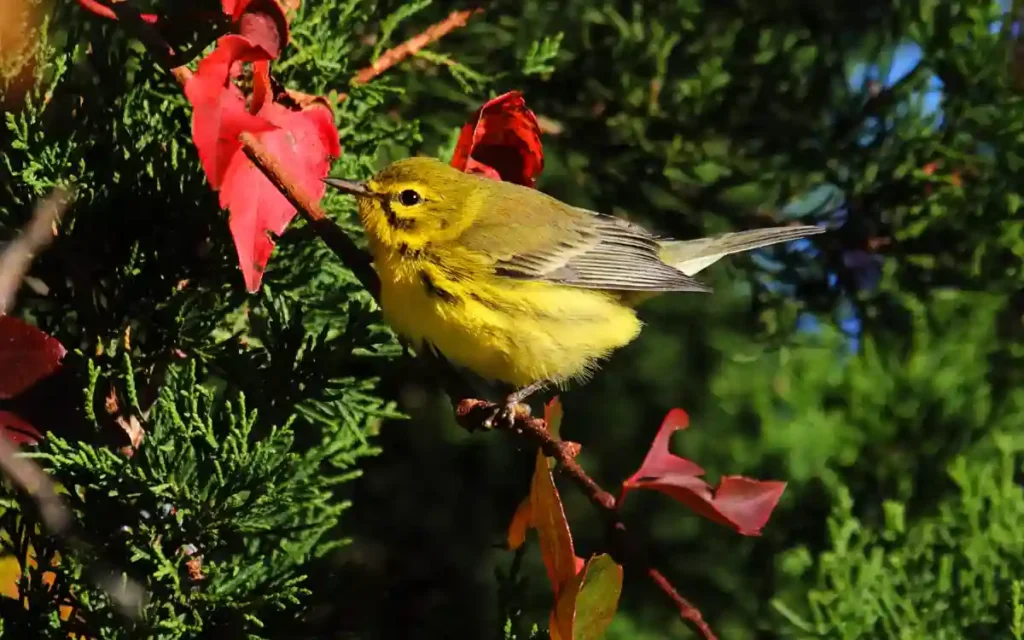
- Length: 4.3 – 5.2 in (11 – 13 cm)
- Weight: 0.3 – 0.5 oz (9 – 15 gm)
- Wingspan: 7 in (18 cm)
- Lifespan: about 3.5 years
Call:-
Prairie Warblers are often seen in shrubby habitats, where they flit about in search of insects. Their melodious songs resemble a series of ascending buzzes and trills.
These birds undertake long migrations, traveling as far as the Caribbean during the winter
Their diet primarily consists of insects and spiders, making them valuable allies in controlling pest populations.
Breeding season usually commences in May. Prairie Warblers lay 3-5 eggs per clutch, which are pale and speckled with reddish-brown markings.
11. Yellow Warbler – (Setophaga petechia)

- Length: 4.7 – 5.1 in (12 – 13 cm)
- Weight: 0.3 – 0.4 oz (9 – 11 gm)
- Wingspan: 6.3 – 7.9 in (16 – 20 cm)
- Lifespan: about 3-10 years
Call:-
Yellow Warblers, are aptly named for their vibrant yellow plumage. These small birds are found throughout North America and are a common sight in gardens and wetlands.
Their cheerful “sweet-sweet-sweet, I’m so sweet” song is unmistakable and a true herald of spring.
They are skilled foragers, adept at gleaning insects from leaves and branches.
Some populations of Yellow Warblers are known to engage in brood parasitism, laying their eggs in the nests of other bird species.
Yellow Warblers are insectivores, with their diet consisting mainly of caterpillars, spiders, and insects.
These warblers build cup-shaped nests in shrubs or trees, often near water sources. Their nests are typically constructed with plant materials, grass, and fine roots.
Breeding season starts in late May or early June. Yellow Warblers lay 3-5 eggs, which are pale blue with speckles.
12. Orchard Oriole Female (Icterus spurius)

- Length: 5.9 – 7.1 in (15 – 18 cm)
- Weight: 0.6 – 1.0 oz (16 – 28 gm)
- Wingspan: 9.8 in (25 cm)
- Lifespan: about 5 – 9 years
Call:-
Orchard Orioles, scientifically referred to as Icterus spurius, are known for their striking plumage. Female Orchard Orioles, in particular, exhibit a subtle charm in their appearance.
Female Orchard Orioles have olive-yellow plumage, which blends seamlessly with their habitat.
These birds are primarily insect eaters, occasionally indulging in fruit.
Orchard Orioles are skilled at weaving intricate hanging nests in deciduous trees.
Their pendulous nests are a marvel of avian architecture, often found hanging from the tips of branches.
Breeding season for Orchard Orioles begins in May. They lay clutches of 3-6 eggs, which are pale blue with small speckles.
13. Nashville Warbler – (Leiothlypis ruficapilla)
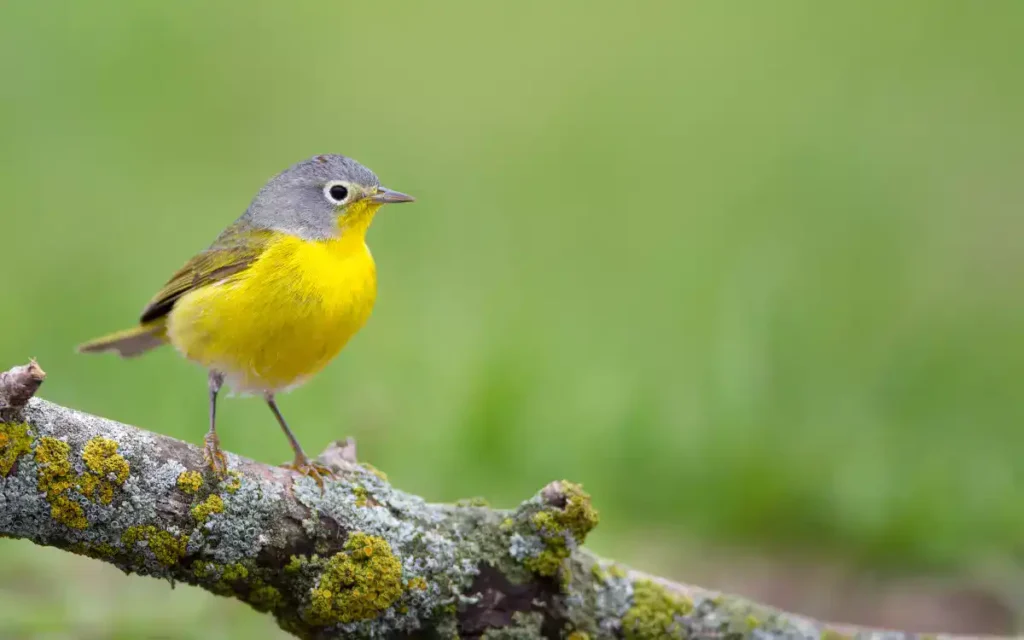
- Length: 4.3 – 5.1 in (11 – 13 cm)
- Weight: 0.2 – 0.5 oz (6.7 – 13.9 gm)
- Wingspan: 6.7 – 7.9 in (17 – 20 cm)
- Lifespan: about 10 years 2 months
Call:-
Nashville Warblers are known for their bright yellow throats and distinctive eye rings.
They are agile insect hunters, often capturing prey mid-flight.
These warblers undertake impressive migrations, covering thousands of miles each year.
Their diet consists mainly of insects, spiders, and small invertebrates found in forested areas.
They are constructed cup-shaped nests on the ground, often hidden under dense vegetation. These nests are lined with moss, bark, and hair.
Breeding season begins in June. Nashville Warblers lay 4-6 eggs per clutch, which are creamy-white with speckles.
14. Western Tanager – (Piranga ludoviciana)
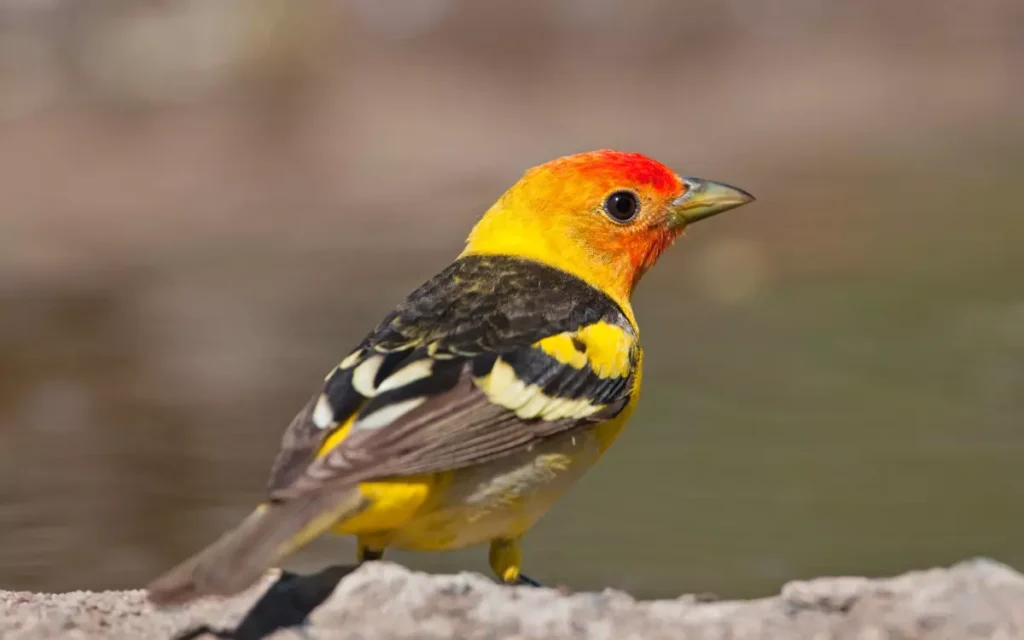
- Length: 6.3 – 7.5 in (16 – 19 cm)
- Weight: 0.8 – 1.3 oz (24 – 36 gm)
- Wingspan: 11.5 in (29 cm)
- Lifespan: about 8 to 15.3 years
Call:-
Male Western Tanagers sport striking redheads and bright yellow bodies.
Their melodious songs echo through coniferous forests during the breeding season.
They are known to eat a variety of insects and fruits.
These tanagers have a diverse diet, consisting of insects, berries, and nectar.
They build cup-shaped nests high in coniferous trees, often concealing them amidst dense foliage.
Breeding season typically starts in May. Western Tanagers lay 2-5 pale blue-green eggs.
15. Wilson’s Warbler – (Cardellina pusilla)
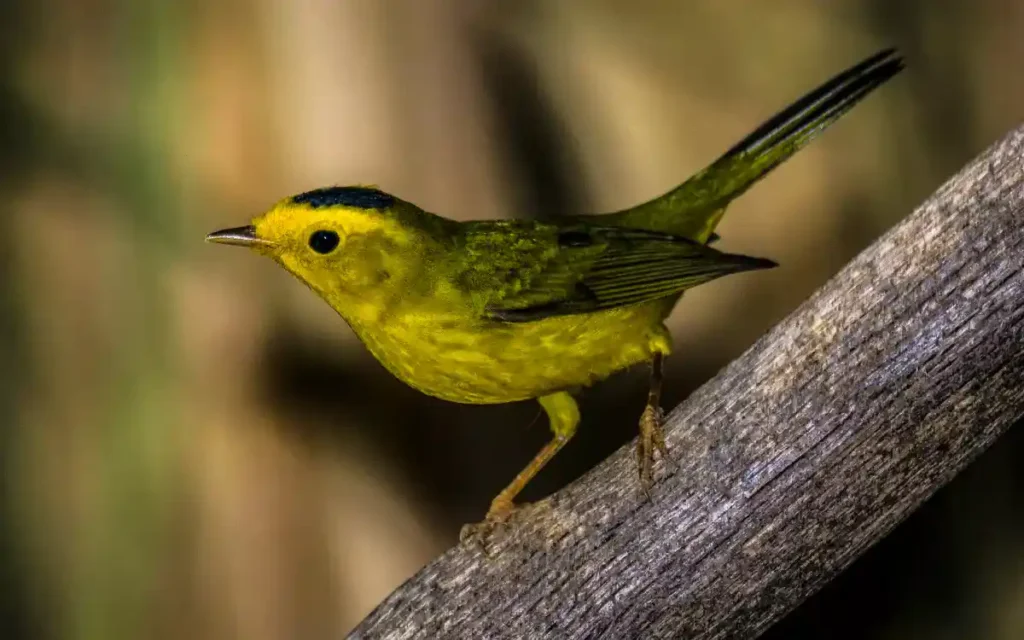
- Length: 3.9 – 4.7 in (10 -12 cm)
- Weight: 0.2 – 0.3 oz (5 -10 gm)
- Wingspan: 5.5 – 6.7 in (14 -17 cm)
- Lifespan: about 6 to 8 years
Call:-
Wilson’s Warbler, is a small, vibrant songbird. These warblers are known for their constant motion and energetic foraging.
Their bright yellow plumage and distinctive black caps make them easily recognizable.
Wilson’s Warblers primarily feed on insects, spiders, and small invertebrates, making them valuable pest controllers. They construct cup-shaped nests in dense shrubs or low vegetation, often close to water sources.
Breeding season typically begins in May, and they lay 4-6 creamy white eggs with fine speckles.
Read also:-
- 41 Species of Ducks Found in Texas (Identification, Calls)
- 9 Type Geese of Texas You See
- 9 Wrens In Texas That look like Wonderful
16. Western Meadowlark – (Sturnella neglecta)
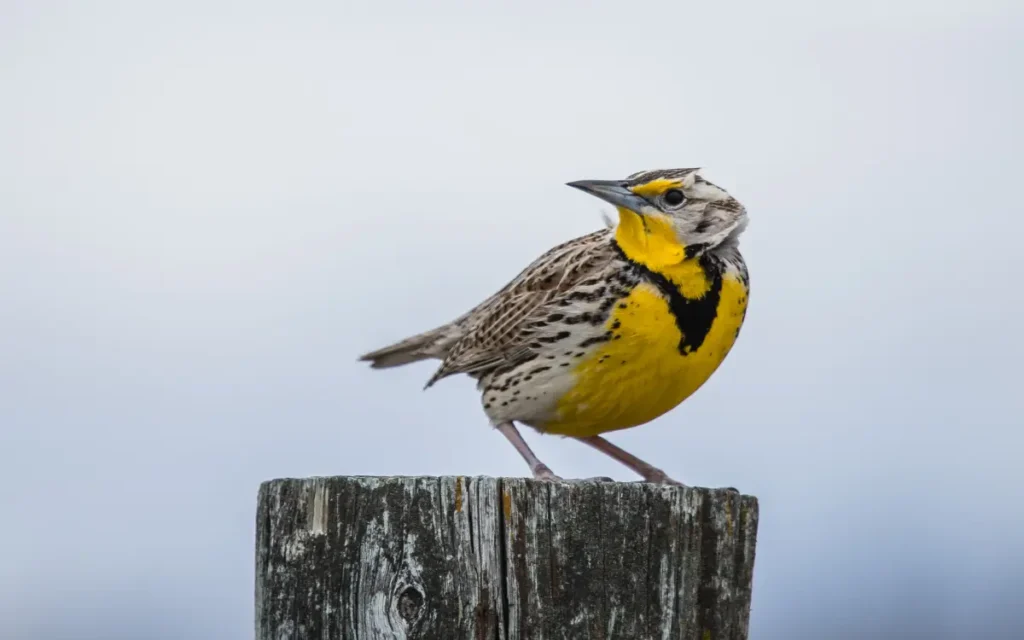
- Length: 6.3 – 10.2 in (16 – 26 cm)
- Weight: 3.1 – 4.1 oz (89 -115 gm)
- Wingspan: 16.1 in (41 cm)
- Lifespan: about 5 to 8 years
Call:-
Western Meadowlarks, scientifically known as Sturnella neglecta, are striking birds found in North America’s grasslands. They have bright yellow plumage and distinctive black V-shaped markings on their chests.
These skilled songsters fill the air with sweet, flute-like calls. Western Meadowlarks are omnivorous, feasting on insects, seeds, and even small vertebrates. They build ground nests hidden amidst grasses and vegetation.
Breeding season starts in April, and they lay 2-7 pale blue eggs with speckles.
17. Altamira Oriole – (Icterus gularis)

- Length: 8.3 – 9.8 in (21-25 cm)
- Weight: 1.7 – 2.3 oz (47- 64 gm)
- Wingspan: 14.2 in (36 cm)
- Lifespan: up to 11.5 years
Call:-
Adult male Altamira Orioles have striking bright orange plumage on their body, wings, and tail. They also have a black face mask that extends from their bill to their eyes.
Females and immature birds are not as vibrant in color, with olive-yellow feathers and a more subdued face pattern. Both males and females have long, pointed bills and dark eyes.
They are known for their melodious songs, which are often a mix of whistles, trills, and musical notes. They build hanging, pouch-like nests made of grasses, fibers, and other materials, often suspended from the tips of palm fronds or other suitable vegetation
These orioles primarily feed on nectar, fruit, and insects. They build hanging nests high in trees, intricately weaving plant fibers and grasses.
Breeding season for Altamira Orioles typically occurs from March to July., and they lay 3-4 pale blue eggs.
18. Hooded Warbler – (Setophaga citrina)
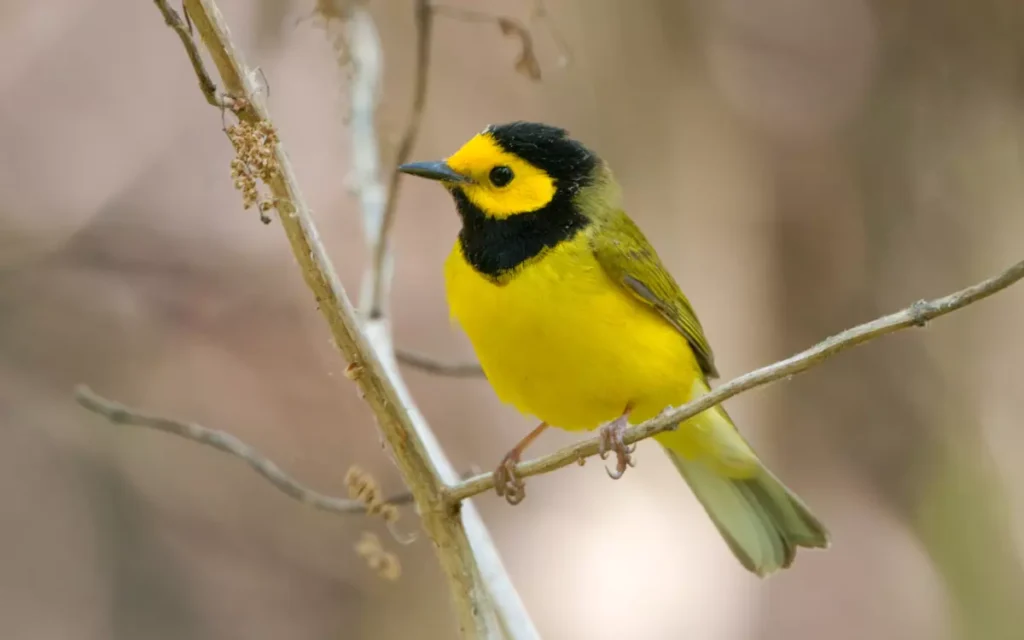
- Length: 5.1 in (13 cm)
- Weight: 0.3 – 0.4 oz (9 -12 gm)
- Wingspan: 6.9 in (17.5 cm)
- Lifespan: about 8 years
Call:-
Male Hooded Warblers are distinctive with their striking black hoods and bright yellow faces, throats, and underparts. They have olive-green upperparts and wings with white markings on their tail feathers.
The female Hooded Warbler is less colorful, with a duller olive-green hood and a yellowish face and underparts. Both males and females have dark legs and a slender, pointed bill.
Their diet consists mainly of insects, including caterpillars, beetles, and spiders.
They forage actively in the understory and lower canopy of trees and shrubs.
Males perform a distinctive courtship display called the “butterfly flight,” where they spread their wings and tails to reveal their bright plumage to potential mates.
The breeding season for Hooded Warblers typically occurs from late April to early August. Females lay a clutch of 3 to 5 pale blue eggs. Both parents participate in feeding and caring for the young birds.
19. Magnolia Warbler (Setophaga magnolia)
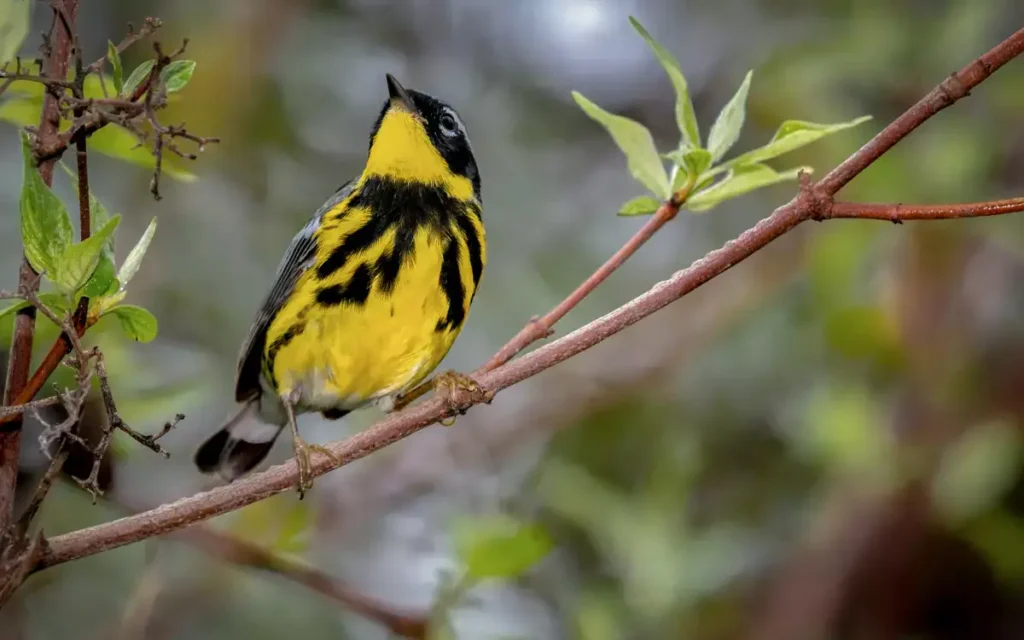
- Length: 4.3 – 5.1 in (11-13 cm)
- Weight: 0.2 – 0.5 oz (6-15 gm)
- Wingspan: 6.3 – 7.9 in (16 – 20 cm)
- Lifespan: up to 6 years
Call:-
Magnolia Warblers are easily recognizable due to their bold and distinctive plumage.
They have a bright yellow throat and underparts, which contrast sharply with a dark, black-streaked back and wings.
A prominent white eyering encircles their dark eyes.
The male Magnolia Warbler has a black necklace or bib, while the female may have a more subdued version of this feature. They are often found in mature forests and forest edges.
Magnolia Warblers are known for their high-pitched, musical song, which is a series of sweet, warbling notes. They are found in North America’s boreal forests during the breeding season. These warblers primarily feed on insects, spiders, and small invertebrates. They construct cup-shaped nests in shrubs or low trees.
Breeding season begins in May, and they lay 4-5 pale blue eggs with speckles.
20. Yellow-throated Warbler – (Setophaga dominica)
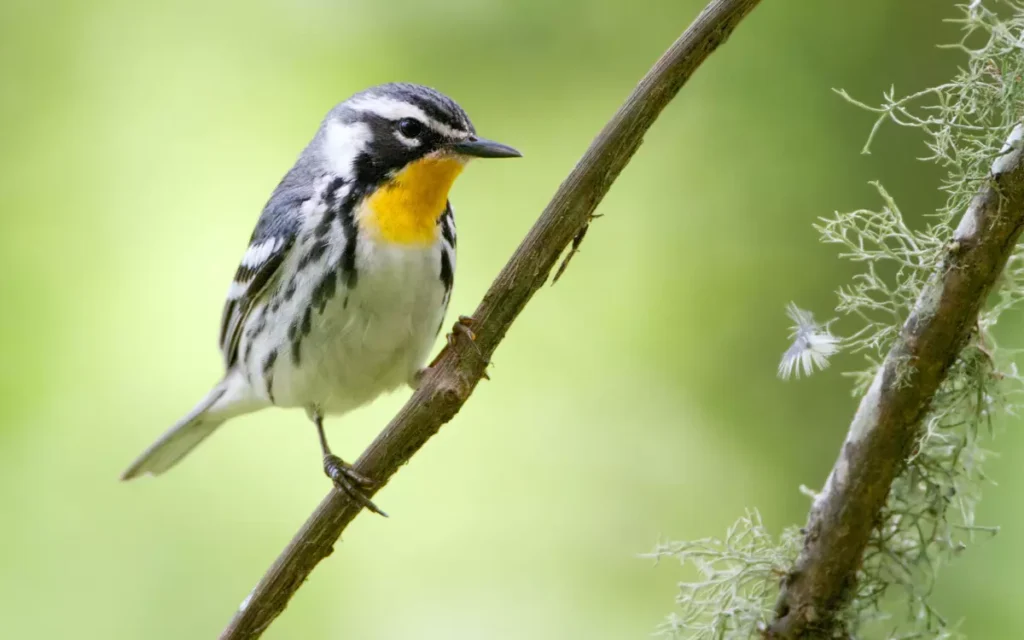
- Length: 5.1– 5.5 in (13 –14 cm)
- Weight: 0.3 – 0.4 oz (8.5 –11.3 gm)
- Wingspan: 8.3 inches (21 cm)
- Lifespan: about 6 years and 10 months
Call:-
Yellow-throated Warblers often join mixed-species flocks during migration, which can include a variety of bird species for added protection.
The Yellow-throated Warbler is a striking songbird with a bold black mask and a vibrant yellow throat. These small, agile birds are insectivores, expertly capturing insects on the wing as they dart through the treetops.
They’re known for their sweet, melodious songs that resonate through deciduous forests. Yellow-throated Warblers construct their nests high in tree branches, making them challenging to observe.
During the breeding season, which usually occurs in late spring, they lay 3-6 eggs.
21. Yellow-throated Vireo (Vireo flavifrons)
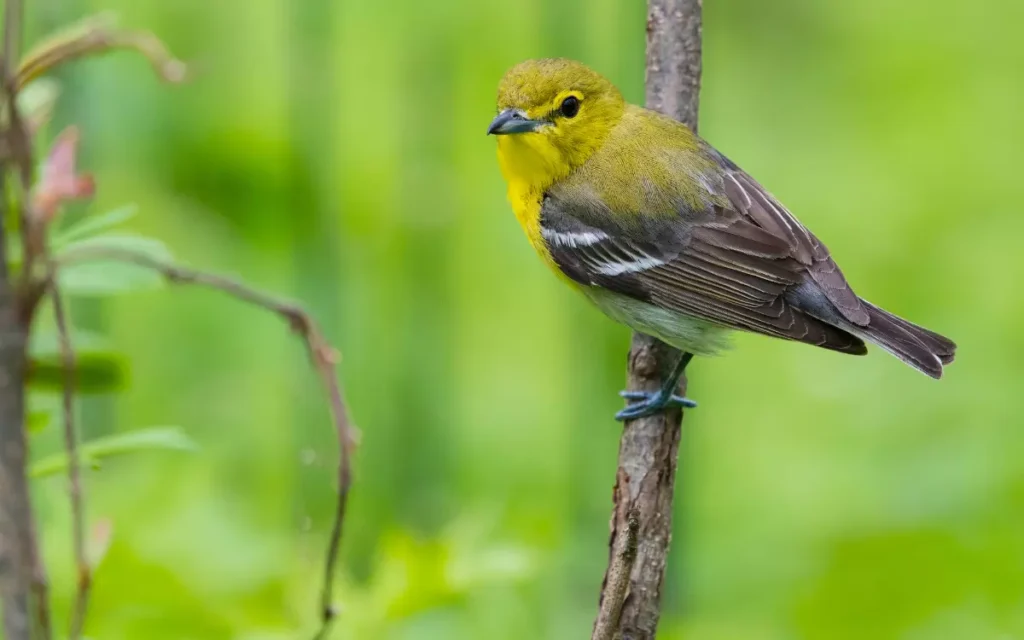
- Length: 5.1 – 5.9 in (13 -15 cm)
- Weight: 0.5 – 0.7 oz (15 – 21 gm)
- Wingspan: 9.1 in (23 cm)
- Lifespan: about 6 – 8 years
Call:-
These vireos are known for their persistent and cheerful singing, which helps birdwatchers identify their presence in North American forests. They have a gray crown with a black line through their eyes, which makes their facial features stand out.
Yellow-throated Vireos are small, lively songbirds with a distinctive yellow throat patch. Their diet primarily consists of insects and spiders, which they capture while foraging in the treetops. They also prefer deciduous and mixed woodlands, especially those near water sources like rivers and swamps.
They can also be found in forested areas with tall trees, often nesting in the upper canopy
They build hanging cup-shaped nests from twigs and fibers. During the breeding season, typically in late spring to early summer, they lay 3-5 eggs.
22. Tropical Kingbird – (Tyrannus melancholicus)
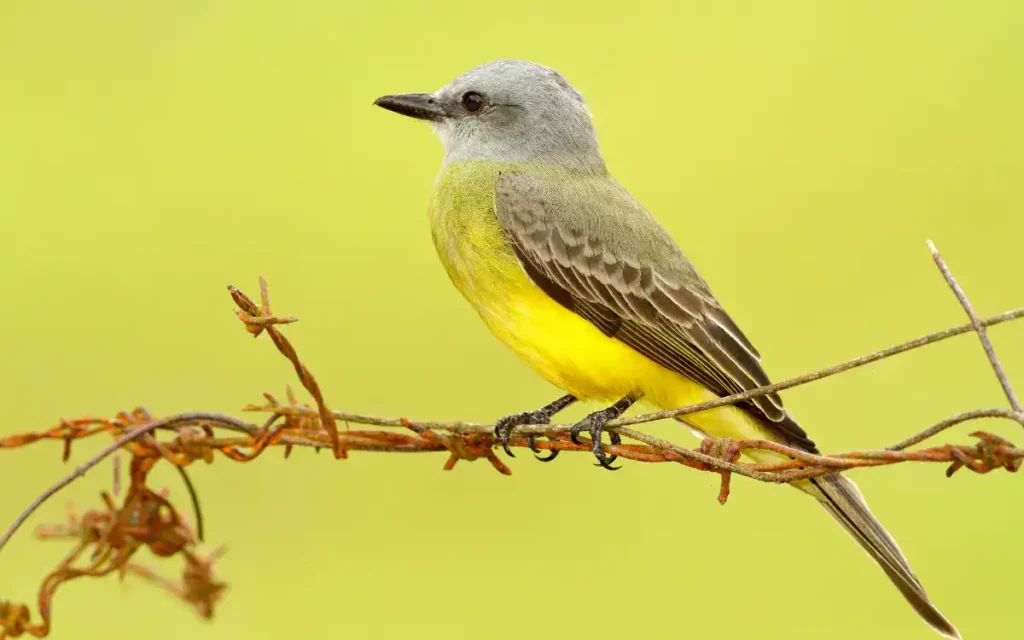
- Length: 7.1 – 9.1 in (18-23 cm)
- Weight: 1.1 – 1.5 oz (32 – 43 gm)
- Wingspan: 12.5 in (31.75 cm)
- Lifespan: about 6 years
Call:-
Tropical Kingbirds are known for their incessant and distinctive calls, which sound like a loud “tsip” or “ki-ki-ri-ki.” They are often vocal and can be heard frequently in their habitat.
The Tropical Kingbird’s diet primarily consists of insects, with a particular preference for flying insects like bees, wasps, flies, and flying ants. They catch their prey using quick, precise strikes in mid-air.
Tropical Kingbirds construct cup-shaped nests using twigs, grass, and plant fibers. They may incorporate spider silk into the nest to strengthen it.
Females typically lay clutches of 2 to 4 eggs, which are pale in color with speckles or spots.
23. Scarlet Tanager Female – (Piranga olivacea)

- Length: 6.3 – 6.7 in (16 -17 cm)
- Weight: 0.8 – 1.3 oz (23 – 38 gm)
- Wingspan: 9.8 – 11.4 in (25 – 29 cm)
- Lifespan: about 12 years
Call:-
While male Scarlet Tanagers boast brilliant scarlet plumage, females exhibit olive-green feathers, helping them blend in while nesting.
Scarlet Tanagers primarily feed on insects, including beetles, caterpillars, and spiders. During migration and on their wintering grounds, they may also consume fruits.
Females build cup-shaped nests in the forest canopy, carefully concealing them among leaves.
These nests are usually constructed using twigs, grass, and plant fibers.
Breeding season occurs during late spring and early summer, typically from May to June in North America.
Females lay 3 to 5 pale blue-green eggs with brown speckles.
25. Prothonotary Warbler – (Protonotaria citrea)
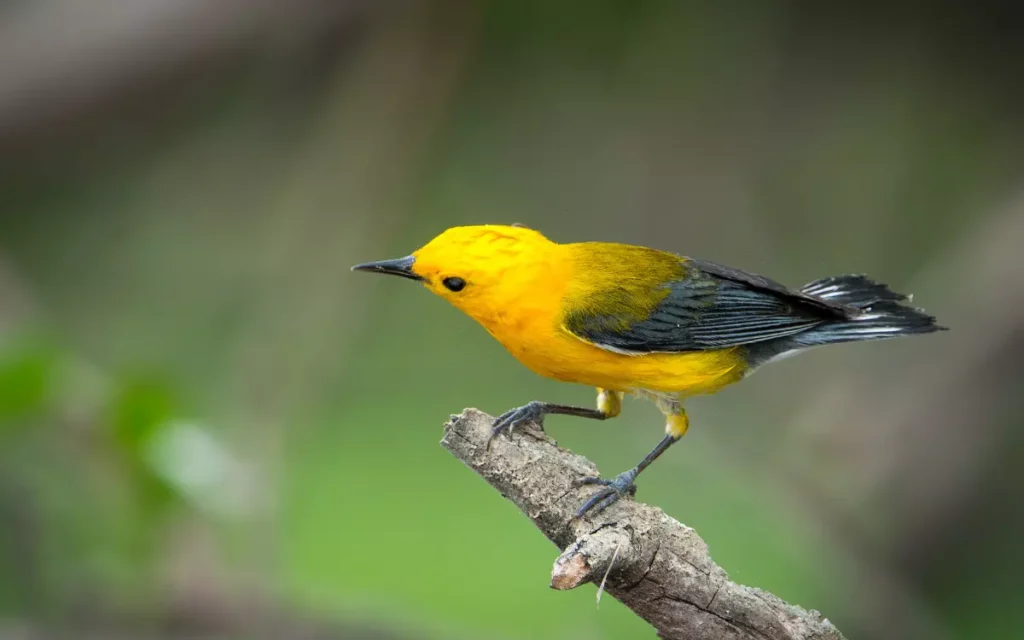
- Length: 5.1 – 5.5 in (13 -14 cm)
- Weight: 0.44 – 0.49 oz (12.5 -14 gm )
- Wingspan: 8.7 in (22 cm)
- Lifespan: about 4 years
Call:-
Prothonotary Warblers are known for their striking lemon-yellow plumage, which makes them stand out in the lush, swampy habitats they prefer.
These warblers primarily feed on insects and spiders, foraging among vegetation, tree branches, and water surfaces. They occasionally eat berries and fruits.
Prothonotary Warblers often nest in cavities created by woodpeckers or in natural tree holes near wetlands and swamps.
They may also use nest boxes if available.
Females lay 3 to 7 eggs, which are creamy-white with brown speckles.
26. Yellow-headed Blackbird – (Xanthocephalus xanthocephalus)

- Length: 8.3 -10.2 in (21 – 26 cm)
- Weight: 1.6 – 3.5 oz (44 – 100 gm)
- Wingspan: 16.5 -17.3 in (42- 44 cm)
- Lifespan: about 10-11.8 years
Call:-
Adult males have a brilliant yellow heads and necks, contrasting with their black body and white wing patches. Females, on the other hand, have a more subdued brownish-black plumage.
Their diet mainly consists of insects, seeds, and aquatic invertebrates. During the breeding season, they also feed on a variety of small animals.
These birds construct their nests within dense marsh vegetation, weaving them into the tall grasses and cattails.
The nests are often suspended above the water to protect them from predators.
The breeding season typically occurs from late spring to early summer.
Female Yellow-headed Blackbirds lay clutches of 3 to 5 eggs. The eggs are pale blue or green with speckles.
27. Blue-winged Warbler – (Vermivora cyanoptera)

- Length: 4.3 – 4.7 in (11-12 cm)
- Weight: 0.3 – 0.37 oz (7.9 -10.5 g)
- Wingspan: 5.9 – 6.75 in (15 -17.15 cm)
- Lifespan: about 9 years
Call:-
Adult males sport bright yellow plumage with bold black streaks on their sides and a blue-gray patch on their wings. Females have more subdued coloring.
Migration Patterns: These warblers are migratory birds, spending winters in Central America and breeding in eastern North America.
Their diet mainly consists of insects, caterpillars, and spiders, which they glean from foliage and branches.
Blue-winged Warblers often nest on the ground or in shrubs close to the ground. They create open-cup nests made of grass, leaves, and plant fibers.
The breeding season typically occurs in late spring and early summer.
Female Blue-winged Warblers lay clutches of 4 to 6 eggs, which are creamy-white with fine speckles.
28. Scott’s Oriole –(Icterus parisorum)
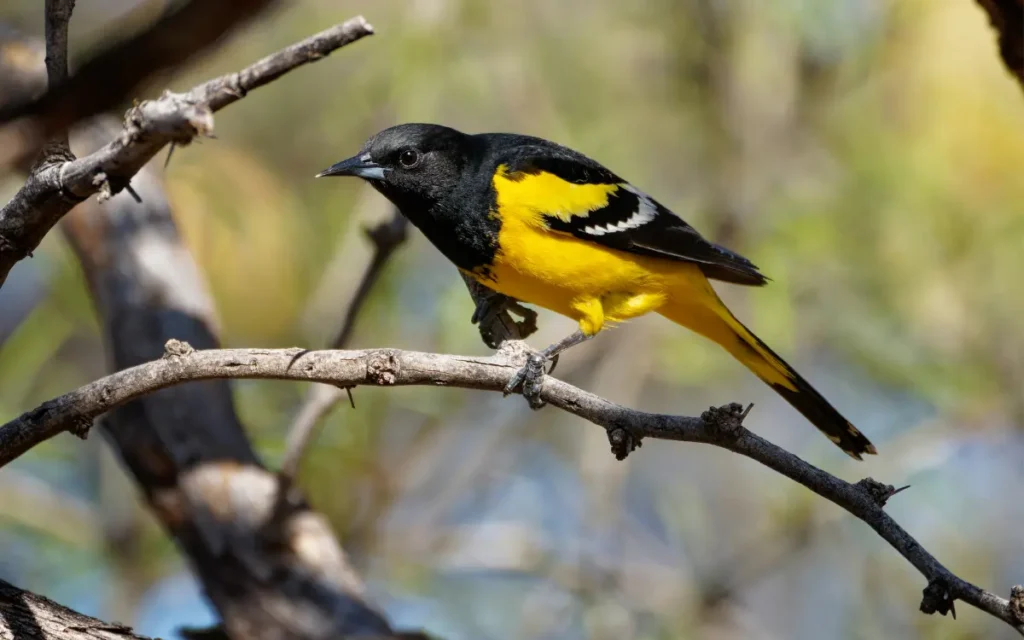
- Length: 9.1 in (23 cm)
- Weight: 1.1 – 1.4 oz (32 – 41 gm)
- Wingspan: 12.6 in (32 cm)
- Lifespan: about 6 – 7 years
Call:-
Adult male Scott’s Orioles are known for their striking yellow plumage, with a black face mask and bib, while females have more subdued olive-yellow coloring.
These orioles have a melodious and complex song, which they use to communicate with each other and establish territories.
Their diet primarily consists of insects, nectar, and fruit. They are also known to sip nectar from agave plants.
Scott’s Orioles build pendulous nests, often hanging from the tips of palm fronds or other vegetation. Their nests are intricately woven and can provide a safe haven for their eggs and chicks.
Breeding typically occurs from late spring to early summer, coinciding with the availability of their preferred food sources.
Female Scott’s Orioles lay clutches of 3 to 5 eggs, which are pale blue or greenish in color with fine markings.
29. Audubon’s Oriole – (Icterus graduacauda)

- Length: 7.5 – 9.4 in (19 – 24 cm)
- Weight: 1.1 – 1.9 oz (31- 53 gm)
- Wingspan: 12.6 in (32 cm)
- Lifespan: about 7 to 10 years
Call:-
Adult males are known for their striking black plumage with bright blue patches on their wings and tails. Females, while less vibrant, display subtle blue accents. Audubon’s Orioles are known for their secretive behavior, often staying concealed in dense foliage.
Their diet primarily consists of insects, fruit, and nectar. They use their specialized bills to extract nectar from flowers, making them effective pollinators.
These orioles build pendant-shaped nests suspended from tree branches. They skillfully weave grasses, plant fibers, and other materials into intricate, hanging nests.
Breeding season typically occurs from late spring to early summer. Female Audubon’s Orioles lay clutches of 2 to 5 eggs. The eggs are pale blue or green with fine speckles.
30. Canada Warbler – (Cardellina canadensis)

- Length: 4.7 – 5.9 in (12 -15 cm)
- Weight: 0.3 – 0.5 oz (9-13 gm)
- Wingspan: 6.7- 8.7 in (17- 22 cm)
- Lifespan: up to 7 years.
Call:-
The Canada warbler males have a bright yellow throat and breast, with gray upperparts and a distinctive black “necklace” of streaks. Females and juveniles have similar markings but with paler colors.
These warblers breed in North America and migrate to Central and South America for the winter, making them a neotropical migratory species.
Their diet mainly consists of insects, including caterpillars, beetles, and spiders. They forage actively in shrubs and low vegetation.
They use leaves, grasses, and plant fibers to build their nests, creating a well-concealed and camouflaged structure.
Breeding season typically occurs from late spring to early summer when they return to their northern breeding grounds.
Female Canada Warblers lay clutches of 4 to 5 eggs, which are creamy-white with brown spots.
31. Dickcissel – (Spiza americana )

- Length: 5.5 – 6.3 in (14 -16 cm)
- Weight: 0.9 -1.4 oz (25.6 -38.4 gm)
- Wingspan: 9.8 – 10.2 in (24.8 – 26 cm)
- Lifespan: about 2 to 4 years
Call:-
Adult male Dickcissels display a striking black “V” on their yellow chest, earning them their name due to their “dick-dick-cissel” call. Females and juveniles have more subdued markings.
These birds migrate seasonally between their breeding grounds in North America and their wintering grounds in Central and South America.
Their diet primarily consists of seeds, especially grass seeds, during the breeding season. Insects are also part of their diet, particularly when feeding their young.
Dickcissels construct cup-shaped nests in grassy fields, pastures, or croplands, often concealed amidst tall vegetation.
Breeding season typically occurs from late spring to summer when they return to their breeding territories.
Female Dickcissels lay clutches of 3 to 6 eggs, which are pale green or blue with speckles.
32. Palm Warbler- (Setophaga palmarum)
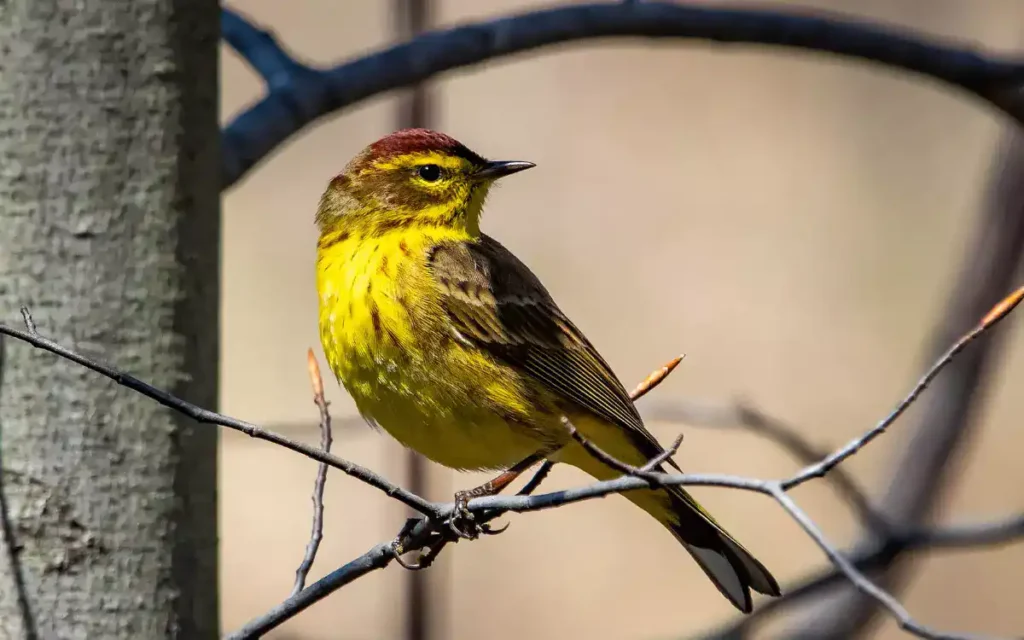
- Length: 4.7- 5.5 in (12 -14 cm) )
- Weight: 0.3 – 0.5 oz (7 -13 gm)
- Wingspan: 7.9 – 8.3 in (20 – 21 cm)
- Lifespan: about 2 to 6 years
Call:-
Palm Warblers have two distinct plumage types: a bright yellow one with chestnut streaking on their belly during the breeding season, and a duller, olive-brown plumage during the non-breeding season.
They are known for their unique tail-wagging behavior, often bobbing their tails up and down while foraging.
Their diet consists mainly of insects, spiders, and small invertebrates. They often forage on the ground, flicking their tails while searching for prey.
They build cup-shaped nests on the ground in dense vegetation, often in open forests, bogs, or wetlands
Breeding season typically occurs from late spring to early summer when they return to their northern breeding grounds.
Female Palm Warblers lay clutches of 4 to 5 eggs, which are pale green or blue with speckles.
33. Couch’s Kingbird – (Tyrannus couchii )
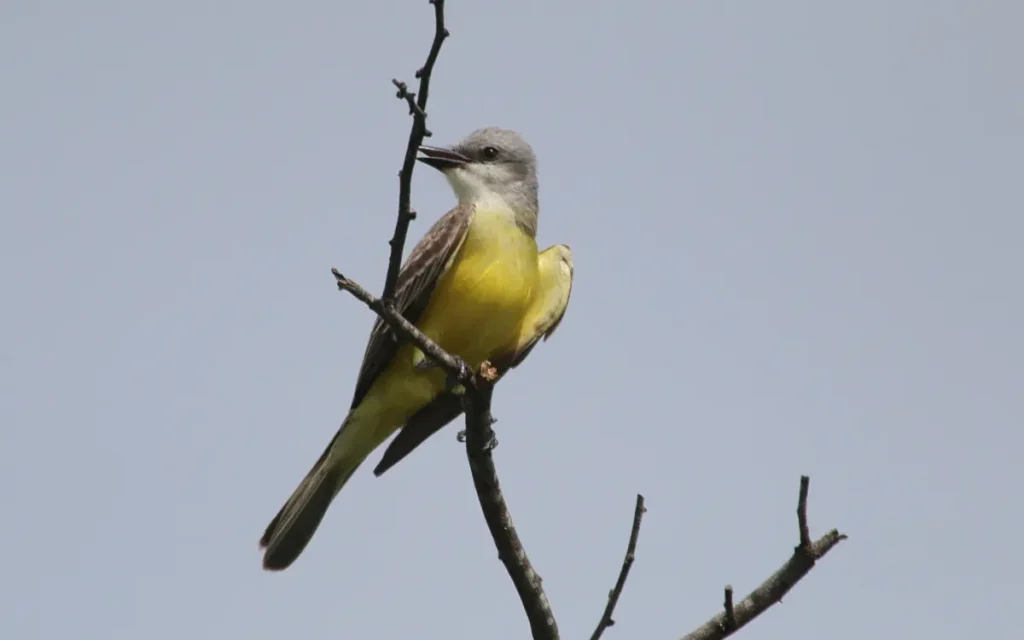
- Length: 7.9 – 9.4 in (20 – 24 cm)
- Weight: 1.4 oz (40 gm)
- Wingspan: 12 -14 in (30 – 36 cm)
- Lifespan: about 4 to 6 years
Call:-
Couch’s Kingbirds have bright yellow underparts, a gray head, and a white throat. They are often recognized by their upright posture and conspicuous crest.
These kingbirds are known for their territorial and sometimes aggressive behavior when it comes to defending their nesting sites.
Their diet primarily consists of insects, which they catch in mid-air during acrobatic flights. They also consume berries and small fruits occasionally.
They build cup-shaped nests in trees or shrubs, often near water sources. The nests are typically made of plant fibers, twigs, and grasses.
Couch’s Kingbirds breed during the summer months, with nesting season typically spanning from late spring to early summer.
Female Couch’s Kingbirds lay clutches of 2 to 5 eggs. The eggs are pale cream or pinkish, often with fine spots.
34. Common Yellowthroat – (Geothlypis trichas)

- Length: 4.3 – 5.1 in (11-13 cm)
- Weight: 0.3 oz (8.5 gm)
- Wingspan: 5.9 -7.5 in (15 -19 cm)
- Lifespan: about 3 to 6 years
Call:-
Common Yellowthroat males are recognized by their striking black mask across the face, while females and juveniles have more subdued plumage.
Common Yellowthroats are known for their cheerful “wichity-wichity” song, which they sing with enthusiasm from dense vegetation.
Their diet primarily consists of insects, spiders, and small invertebrates. They forage close to the ground in marshes, meadows, and wetlands.
They build cup-shaped nests near the ground in thick vegetation, using grasses, leaves, and plant fibers. Their nests are well-hidden.
Breeding season typically occurs from late spring to summer.
Female Common Yellowthroats lay clutches of 3 to 5 eggs, which are creamy-white with fine speckles.
FAQs:
Q: What is the best time to go birdwatching for yellow breast birds in Texas?
A: The best time to spot yellow breast birds in Texas is during the spring and fall migration seasons when they pass through the state.
Q: Can I attract yellow breast birds to my backyard?
A: Yes, you can attract these birds by providing suitable feeders and planting native trees and shrubs that offer food and shelter.
Q: Are yellow breast birds endangered?
A: Yellow warblers and yellow-throated warblers are not endangered. However, the yellow-breasted chat is listed as near-threatened due to habitat loss.
Q: How can I differentiate between male and female yellow breast birds?
A: In most species, males tend to have brighter and more vibrant yellow plumage, while females may have slightly duller colors.
Q: What is the lifespan of yellow breast birds?
A: Yellow breast birds typically live for 2 to 5 years in the wild, depending on various factors like predation and habitat.
Q: Can I listen to the songs of yellow breast birds online?
A: Yes, there are numerous websites and apps dedicated to bird songs and calls where you can listen to recordings of yellow-breasted birds.

